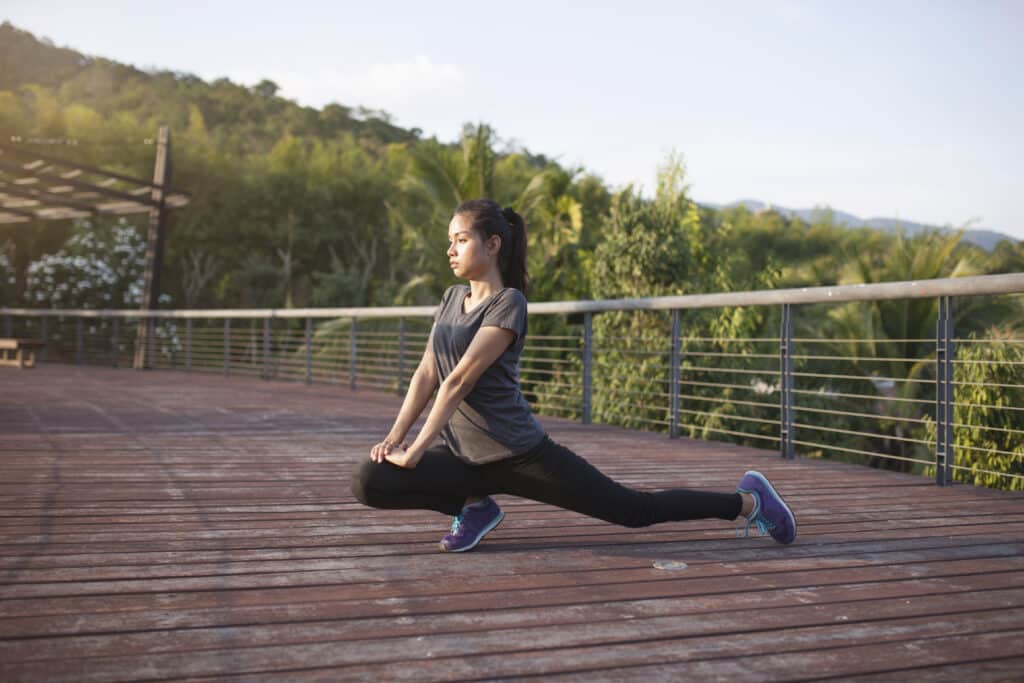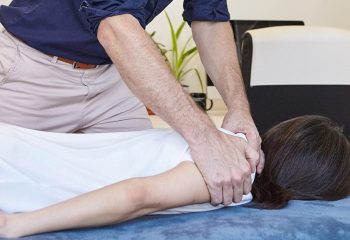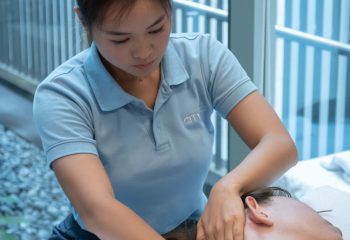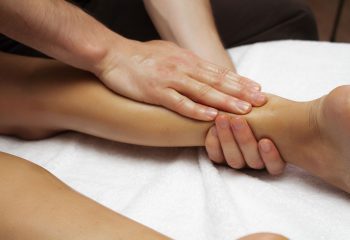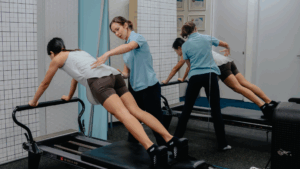Struggling with a Hamstring Injury? Here’s How to Heal Faster!
If you’ve ever experienced the sharp, nagging pain of a hamstring injury, you know just how limiting it can be. Whether it’s the result of a sudden movement, overuse, or prolonged tension, hamstring injuries can prevent you from doing even the simplest daily activities. These muscles, located at the back of your thighs, are essential for walking, running, bending, and sitting. When they’re hurt, movement becomes difficult, and recovery can be slow.
However, the good news is that with the right treatment and targeted hamstring stretches, healing can be quicker, and the risk of re-injury can be significantly reduced. Stretching is a fundamental component of your recovery plan and plays an essential role in regaining mobility and flexibility in your hamstrings. Let’s explore what causes hamstring injuries, the signs to watch for, and, most importantly, how to use hamstring stretches to speed up your recovery.
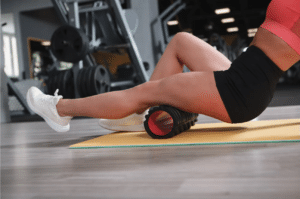
What Causes Hamstring Injuries?
Hamstring injuries can happen in various ways, but they are most often the result of overstretching, sudden movements, or repetitive strain. These muscles play a critical role in your body’s movements, supporting your hips and knees. Injuries often occur when there’s an imbalance between the hamstrings and other muscles, when there’s insufficient flexibility, or when you suddenly push your body too hard during physical activity.
Common Causes of Hamstring Strain:
- Overexertion during sports or physical activity.
- Skipping warm-ups, which include hamstring stretches, before a workout.
- Muscle imbalances that place additional strain on the hamstrings.
- Sudden, explosive movements, such as sprinting, jumping, or changing direction quickly.
- Prolonged sitting without stretching or moving, which causes muscles to tighten over time.
Signs You May Have a Hamstring Injury
Recognising a hamstring injury early on can help you address it quickly and prevent further damage. Some common symptoms to watch out for include:
- Sharp or aching pain in the back of the thigh (especially when moving or stretching).
- Swelling or bruising, which may appear in more severe cases.
- Difficulty extending or straightening your leg fully.
- Tightness and stiffness in the hamstrings, especially after physical activity.
If you’ve experienced any of these symptoms, it’s crucial to take action. Ignoring hamstring discomfort can lead to long-term pain or a chronic injury, making recovery harder. Stretching exercises can be one of your most effective tools for healing and preventing future injuries.
5 Easy Hamstring Stretch Exercises to Help You Heal
While rest is essential during recovery, incorporating gentle stretches into your daily routine can speed up the healing process and help you regain flexibility. Here are five simple hamstring stretch exercises that target the hamstrings while promoting healing and improving your range of motion.
1. Seated Hamstring Stretch
- How to do it: Sit on the floor with one leg extended straight in front of you and the other leg bent so that the foot is placed against your inner thigh.
- How it helps: This is a gentle stretch that targets the hamstrings while also promoting flexibility in the lower back and hips.
- Hold for: 20-30 seconds, then switch legs. Repeat 2-3 times for each leg.

2. Standing Hamstring Stretch
- How to do it: Place one foot on a raised surface like a chair, step, or low table. Keep the extended leg straight while gently leaning forward from your hips, aiming to reach your toes.
- How it helps: This variation of the hamstring stretch works to lengthen the back of the leg and can be modified for different flexibility levels.
- Hold for: 20-30 seconds, then switch legs. Repeat 2-3 times for each leg.
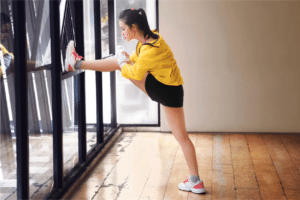
3. Lying Hamstring Stretch with a Strap
- How to do it: Lie on your back and loop a towel, strap, or resistance band around the arch of one foot. Keep the opposite leg flat on the floor and gently pull the band to raise your leg, keeping it straight.
- How it helps: This stretch isolates the hamstrings while maintaining a controlled stretch. The band provides support, making it easier to hold the position.
- Hold for: 20-30 seconds, then switch legs. Repeat 2-3 times for each leg.
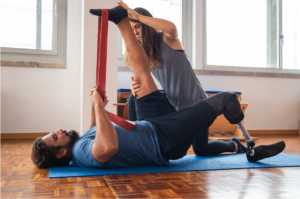
4. Dynamic Hamstring Stretch (Leg Swings)
- How to do it: Stand tall and swing one leg forward and backward in a controlled motion. Keep your movements slow and deliberate to avoid overextending the muscles.
- How it helps: Dynamic stretches like leg swings are excellent for warming up the muscles and improving flexibility without holding a position for too long.
- Repeat for: 10-15 swings per leg.

5. Wall Hamstring Stretch
- How to do it: Lie on your back with one leg extended up against a wall, keeping the other leg flat on the ground. Hold your leg in place as you gently deepen the stretch.
- How it helps: This stretch targets the hamstrings and lower back while giving you the support of the wall to hold your leg in position.
- Hold for: 20-30 seconds, then switch legs. Repeat 2-3 times for each leg.
How to Prevent Future Hamstring Injuries
Once you begin to feel better, it’s important to continue taking care of your hamstrings to avoid re-injury. Here are some helpful tips for maintaining hamstring health and preventing future strain:
- Make stretching part of your daily routine: Consistent hamstring stretches, even on days when you aren’t working out, can keep your muscles flexible and reduce the likelihood of injury.
- Strengthen your hamstrings: Perform gentle exercises like hamstring curls or leg lifts to build strength and prevent muscle imbalances that might lead to injury.
- Gradually increase your workout intensity: If you’re returning to exercise after an injury, avoid pushing yourself too hard too quickly. Slowly ramp up your activity level to give your muscles time to adjust.
- Take breaks from sitting: If your job or lifestyle involves sitting for long periods, get up, walk around, and stretch every 30 minutes or so. This will keep your muscles from becoming tight and stiff.
Get Professional Help for Faster Recovery
If you’ve been dealing with persistent hamstring pain or tightness, it might be time to seek professional help. Our physiotherapist can assess your condition and design a personalised treatment plan that targets your specific needs. They’ll not only help you recover more quickly but also provide you with tools and strategies to prevent future hamstring injuries. With years of experience on their hands & many positive reviews, you can be sure you’re in good hands.
Don’t let your injury hold you back any longer. Schedule a physiotherapy appointment today, and take the first step toward full recovery.
Recover better with hamstring stretches & physiotherapy
Recovering from a hamstring injury requires patience, consistency, and the right approach. With proper care, including stretching, strengthening, and flexibility exercises, you can heal faster and reduce your risk of future injuries. By incorporating hamstring stretches into your daily routine and seeking professional guidance, you’ll be on the road to recovery in no time.

